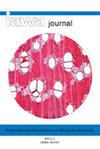基于半薄切片技术的木质部次生细胞壁沉积过程量化方法
IF 1.4
3区 农林科学
Q2 FORESTRY
引用次数: 0
摘要
鉴定木材的形成、细胞壁沉积、木质化和成熟过程有助于更好地了解生物量的积累过程。传统的研究木质部发育的方法受到染色效果和辨别经验的限制,对细胞壁沉积和木质化的程度是不定量的,或者不适合阔叶树。在这项研究中,我们整合了几种现有的方法,以提高细胞发育阶段的判别精度,并定量描述软木和硬木树种的细胞壁沉积和木质化程度。为了做到这一点,我们在中国北京山区的一个生长季节每7-14天收集一次两个物种的树木微卫星,一种是针叶树(Platycladus orientalis),另一种是阔叶树(Acer truncatum)。我们使用半薄切片技术结合偏光显微镜跟踪木质部的发育。这种综合方法可以定量描述硬木和软木树种的木质部细胞壁沉积和木质化过程。该方法可用于证明形成层与木细胞产生之间的动态过程,并描述木细胞从生成到成熟的细胞壁沉积和木质化过程。该方法在林业和生态研究中探索木材形成和积累过程的科学问题具有一定的应用前景。本文章由计算机程序翻译,如有差异,请以英文原文为准。
A semi-thin section technique-based approach to quantify the xylem secondary cell wall deposition process
Identification of wood formation, cell wall deposition, lignification, and the maturation process contribute to a better understanding of biomass accumulation processes. Traditional methods for studying xylem development are limited by dyeing effects and discrimination experience, are non-quantitative for the degree of cell wall deposition and lignification, or are unsuitable for broad-leaved trees. In this study, we integrated several already existing methods to improve the discriminative accuracy of the cell development stage and to quantitatively describe the cell wall deposition and lignification degree for both softwood and hardwood tree species. To do this, we collected tree microcores every 7–14 days during a growing season for two species, one conifer (Platycladus orientalis) and one broad-leaved tree (Acer truncatum), in the mountainous areas in Beijing, China. We tracked the xylem development using semi-thin section technology combined with polarization microscopy. This integrated approach allows a quantitative description of the xylem cell wall deposition and lignification process of both hardwood and softwood tree species. This approach can be applied to demonstrate the dynamic process between the cambium layer and the production of wood cells and to describe the cell wall deposition and lignification process of wood cells from generation to maturation. This approach has certain application prospects for exploring scientific issues related to wood formation and accumulation processes in forestry and ecological studies.
求助全文
通过发布文献求助,成功后即可免费获取论文全文。
去求助
来源期刊

IAWA Journal
农林科学-林学
CiteScore
3.40
自引率
15.80%
发文量
26
审稿时长
>36 weeks
期刊介绍:
The IAWA Journal is the only international periodical fully devoted to structure, function, identification and utilisation of wood and bark in trees, shrubs, lianas, palms, bamboo and herbs. Many papers are of a multidisciplinary nature, linking
 求助内容:
求助内容: 应助结果提醒方式:
应助结果提醒方式:


